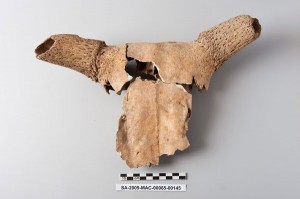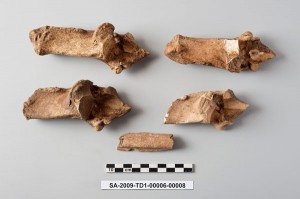A large amount of animal remains have been studied since the very beginning of the excavations at Sagalassos. The analyses yielded information on several aspects of daily life in the city, from the Iron Age (at Tepe Düzen) up to the Middle Byzantine period. The data collected during the 2009 campaign corroborated earlier results and also provided some new elements.

Cattle skull that, together with three other cattle skulls and much more material, was used to block a channel at the Macellum
Animal remains found at Tepe Düzen revealed that the economy was based mainly on the herding and breeding of sheep and goats, and to a lesser extent of cattle and pigs. Sheep and goats are present in about equal proportions and both species provided products, such as milk and wool. Since there is no indication that cattle were frequently used for heavy duty work, these animals were probably raised for their meat and milk. The transport of goods was mainly carried out by donkeys. Wild animals make up a very small part of the faunal assemblage. Nevertheless, remains of red deer an fallow deer are more frequently observed than at Sagalassos, suggesting environmental changes or higher human pressure at the transition from the Iron Age to the Imperial period.
The excavations at the Colonnaded Street have yielded a large collection of animal remains, found in and nearby the fountain along the street. The bones mainly derive from cattle and to a lesser extent from sheep and goat; pig remains are almost completely absent. The skeletal elements of cattle are not evenly distributed within this collection and consist mainly of fragments of mandibles, ribs and the long bones of the fore and hind limbs. In the case of sheep and goat, many horn cores have been collected. This material can interpreted as the refuse of slaughtering and butchery activities. Similar assemblages have been found in the past at the Lower Agora and within the Odeon. These dumps show how abandoned buildings or infrastructure were used to deposit waste by the end of the 6th – 7th century AD.
The excavations at the Domestic Area, on the other hand, yielded this year a bone assemblage that has been interpreted as consumption refuse, more precisely as table and kitchen refuse. This assemblage showed a very high percentage on bones of pig and chicken, followed by sheep and goat. Hare, wild birds (chukar, pigeon, duck) and fish are also well represented. The high abundance of pig remains is very striking and can possibly be linked to the high status of the consumer. Other assemblages of kitchen- and table refuse from the Domestic Area were relatively less rich in pig remains.
In the past remains of eagle owl pellets were collected at the Roman Baths. After identification of the bone remains, the minimum number of preys were calculated. It was concluded from this number that the eagle owl occupied (part of) the building for at least two breeding seasons (De Cupere et al. 2009). More material from eagle owl pellets has now been found in the Roman Baths, indicating that the eagle owl must have been breeding here for an extended period of time. Preys included among others hare, hedgehog, jerboa, migratory hamster, chukar and pigeon. The occupation by eagle owl predates the final, human abandonment of the town and illustrates how this large predator was surprisingly able to live and breed in close vicinity of man.



Fine way of explaining, and nice post to obtain data about my presentation focus, which i am going to present in school.